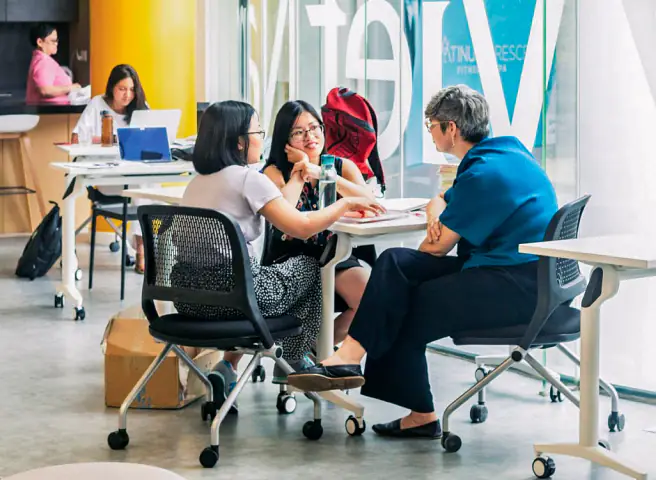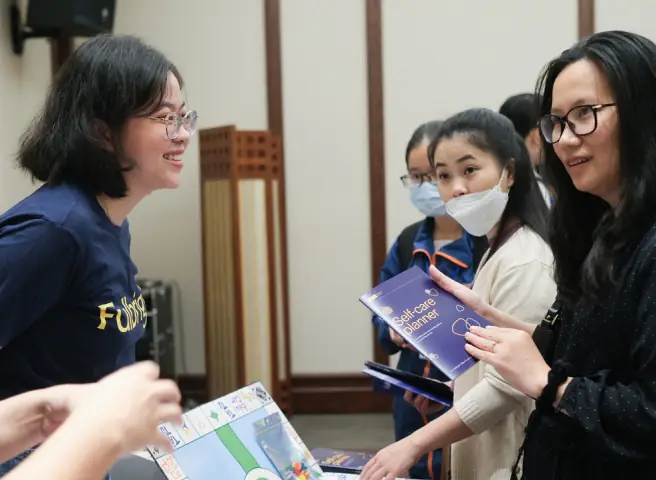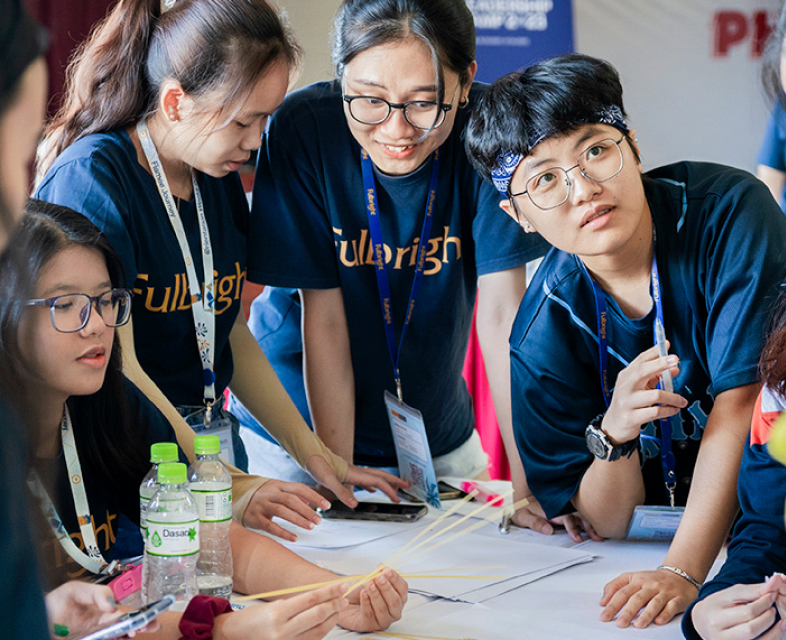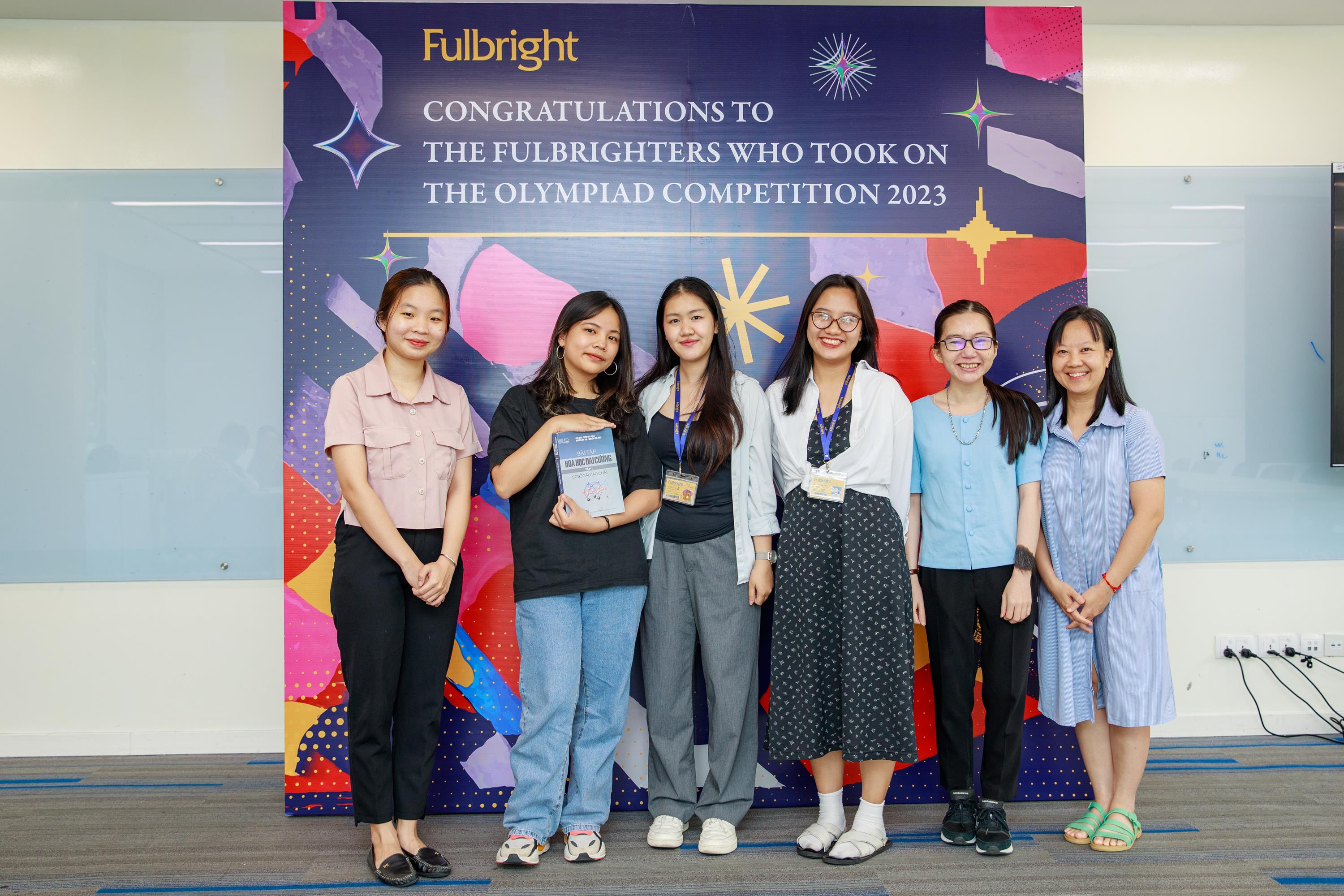
It is a strategic decision that a “engineering-oriented” subject has been chosen as one of the core courses at Fulbright University Vietnam. Design and Systems Thinking’s ultimate goal is not to train students specialized in technology, but to inspire the young generation to empathize with others, think creatively, understand the process and come up with solutions to tackle complex and interdisciplinary challenges of the impatient future.
Design and Systems Thinking evolved from the “Creating and Making” course which was introduced in the co-design year. Initially, it mainly focused on design theories and technical practices. Since the 2020-2021 academic year, the course has undertaken a lot of adjustments in curriculum and its name also changed to Design and Systems Thinking. According to Dr. Trương Trung Kiên, Chair of Engineering at Fulbright, this course was inspired by the academic model of Olin College of Engineering: “Students not only learn technical skills, but they also acquire broader knowledge. They must have entrepreneurial mindsets to understand the needs of users and make impacts on society.”

Students’ products in the co-design year
The course’s name clearly states two modules taught in the course: design thinking focusing on human-centered needs analysis & problem identification, ideation, prototype making & testing; and systems thinking focusing on connections and interactions among components of a product and between the product and its working environment. At present, design thinking still takes up a greater proportion of the course content. Nevertheless, our two lecturers Dr. Nguyễn Hợp Minh and Dr. Trương Trung Kiên are putting more efforts to cultivate and apply systems thinking in lectures and term projects in upcoming semesters.

Dr. Nguyễn Hợp Minh is helping students work on their products in the Makerspace.

Dr. Trương Trung Kiên takes pictures with a group of students after the completion of their final term project.
This course requires students to create and make physical engineering products in the Makerspace. As an essential component, the space offers a diverse selection of equipment ranging from handy tools such as hammers, saws, sewing machines,… to those for manufacturing purposes such as a Computer Numerically Controlled (CNC) cutting machine, 3-dimensional (3D) printers,….It enables students to turn design ideas into actual products. Managing this space since the early days of its establishment, Mr. Trần Thanh Thái, Associate Director of Design & Fabrication Operations at Makerspace, never loses his excitement: “Graduated from Bach Khoa University and spending years in manufacturing corporations, I used to work with many technicians. At Fulbright, the interesting thing is that I’ve been teaching technology to complete novices but dare to explore and experiment. Their fresh minds openly absorb everything”.

The Makerspace comprises a wide range of the most advanced tools.
The “happy moments”
The interweaving and sequencing of theoretical and practical lessons, one of the distinctive features of this course, offers students opportunities to immediately apply knowledge in production. Given that, the curriculum is designed based on the process of the project’s implementation: learning the techniques, understanding the users, ideation, design & proposal pitching, prototyping, testing, and reporting. It is such a challenging yet exciting process since the difficulties lead the learners to wholesome happiness in the end. “I’m glad to be a companion of students on their quest to find those “happy moments”. For example, a group produced a hand-free trash bin which was operated using eye command. They stumbled over a lot of obstacles. They eventually overcame those difficulties, and found their “happy moment” and shared it with everyone, ” Dr. Trương Trung Kiên observed.

Students are discussing their term project in the Makerspace.
Coaching students even in the smallest details, Mr. Thái can’t hide his emotions when recalling his students’ failed experiences. “It’s compulsory to design before making it. Designing a practical model is not easy. I tend to ask them to begin with simple technical drawings, rectangles, for instance, then encourage them to improve on those basic shapes. It’s exhilarating.” There are some groups in which members are completely new to handy tools, let alone large machines. Mr. Thái patiently demonstrated different levels of efficiency of the equipment. In one tutorial, he sawed a wooden panel and “acted” as if it took a lot of effort, then switched to a knife to easily cut and break it into two pieces with his hands. His demonstration boosted students’ confidence to become more comfortable with those machines. “Once, a group proposed a design that required electric welding. Initially, they were afraid of heat and smoke. After I demonstrated the process to show them that it was simpler than they thought, they tried and gradually got used to it. They mastered the skill and were so proud of their products, which made me also very proud.”

Large machines such as wooden cutting machines are arranged far from the learning area to avoid noise.
Equal opportunities in education
The experience of “amateur” technicians is not only fascinating for the students themselves but it also inspires the faculty to bring engineering lessons to life and for everyone. “Today, anyone can produce videos and become a YouTuber, just like how anyone can design and make products in the Makerspace,” said Dr. Nguyễn Hợp Minh.
As an inclusive course, Design and Systems Thinking welcomes participation from people with disabilities. Trần Việt Hoàng, a visually-impaired student, was also a student in Dr. Nguyễn Hợp Minh’s class. Having concerns that technical lessons would make Hoàng’s learning experience difficult, Dr. Minh asked Hoàng in a respectful manner whether or not he needed help. Yet, every time, Hoàng confidently answered “no” because a computer application can help him “read” his lectures and his classmates were always there supporting him. “Disability is still with him, but with assistive technology, Hoàng is capable of doing what he wants. I support him with all of my respect since probably I cannot do what he can do,” Dr. Minh affirmed. Those supporting devices are the very products of human-centered design and systems thinking, those that the course tries to convey to the students.
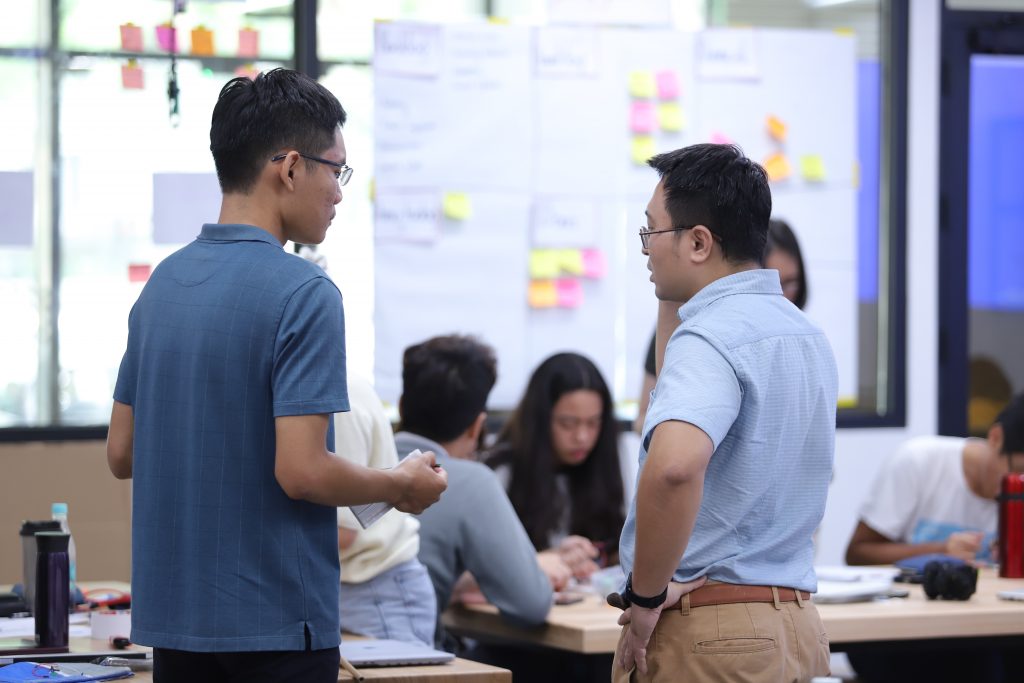
Dr. Nguyễn Hợp Minh is delivering a lecture on theory.
To Đồng Thị Hải Yến, another visually impaired student in Dr. Trương Trung Kiên’s class, this Design and Systems Thinking course has special meanings – a sense of accomplishment and being recognized. “I don’t think I’m ever able to learn such technology-related courses. There would be no opportunity for people like me to practice with industrial machines,” she shared. During her first and second years of high school, due to her condition, Yen was “excused” from works that involved drawing and making in arts and technology classes. “I felt isolated and bored. When my classmates drew and discussed their art pieces, I wished I had joined them. Although I was bad at drawing, I still wanted to try, but even if I tried, no one would guide or evaluate my drawings,” Yến recollected. The enthusiasm and wholehearted support of Mr. Thái, Dr. Kiên, Makerspace’s student assistants and her classmates gave Yến such courage to take part in the learning process.
“Mr. Thái told me to come to the Makerspace every Tuesday. There, he would help me practice with the machines, from the simplest work to complicated ones. It might take me more time and my products didn’t look as good as others’, but at least I could do it when being given proper guidance. Once, my teammates asked me to try the wood-cutting machine, I actually tried it and it was really fun.”
According to Mr. Trần Thanh Thái, another feature that makes teaching technology at Fulbright special is gender equality. “Currently, it’s critical to build favorable conditions for women to participate in STEM. However, at Fulbright, we achieve it effortlessly. Over the years, as I observed, many female students are interested in technology. The first two student assistants of the Makerspace are also female.”
A sense of belonging and community
Although Design and Systems Thinking is still a new course, it has been attracting and nurturing a community interested in technology at Fulbright. “I know the word “community”, yet never see it from an insider’s point of view. The course started from scratch and has been through rounds of renovation. Yet, today, we have a fully-functioning Makerspace with a manager and nearly 20 assistants responsible for different duties. There are even projects that go beyond the limitation of the course, where teachers and students collaborate as partners,” Dr. Minh shared.
A sense of belonging is fostered through collaborations among students with diverse characteristics and strengths. On the teamwork spirit, Nguyễn Tuấn Minh (Class of 2024) from FulbrightTeeth, a team designing an automatic toothpaste dispensing device assisting children and visually-impaired people to get a sufficient amount of toothpaste for proper dental care, shared: “We never put pressure on each other and try to have fun together. It is important to pay attention to and care for each member of the team. When the group is too tense, we stop immediately, and open wheelofnames.com to randomly assign team members the rest of the workload.”

FulbrightTeeth team is always full of positive energy in virtual discussion.
The Hearty Plant project initiated by students, faculty, and staff at Fulbright is also a product of the “community” that Dr. Nguyễn Hợp Minh mentioned. The project incorporates Internet of Things (IoT) technology and agriculture to develop a vertical garden model, which enables urban dwellers to produce their own safe and sustainable food. Prior to the implementation of this project, lecturers took students on a field trip to Tuấn Ngọc farm – a hydroponic model that grows plants originated from Da Lat City under the weather condition of Ho Chi Minh City.
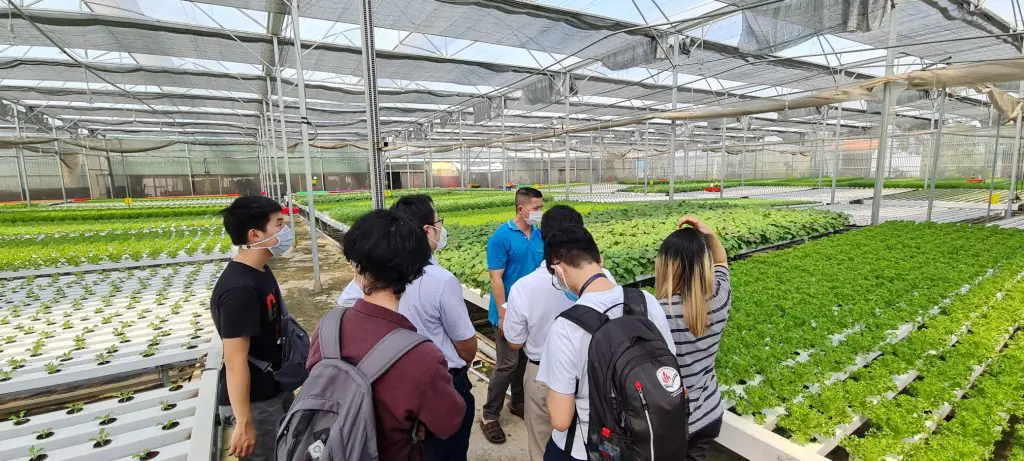
Field trip toTuấn Ngọc Farm


Students are working on the Hearty Plant project with the guidance and support of Dr. Minh and Mr. Thái.
The Design and Systems Thinking course does not test students with easy questions. It offers them an environment to seek human-centered challenges that they desire to solve. To sustain that educational environment, we need to build a community of like-minded, compassionate and creative people. Those are the values that Design and Systems Thinking pursues – a core course related to engineering that is enshrined in the vision and mission of the liberal education at Fulbright University Vietnam.
An Bình
